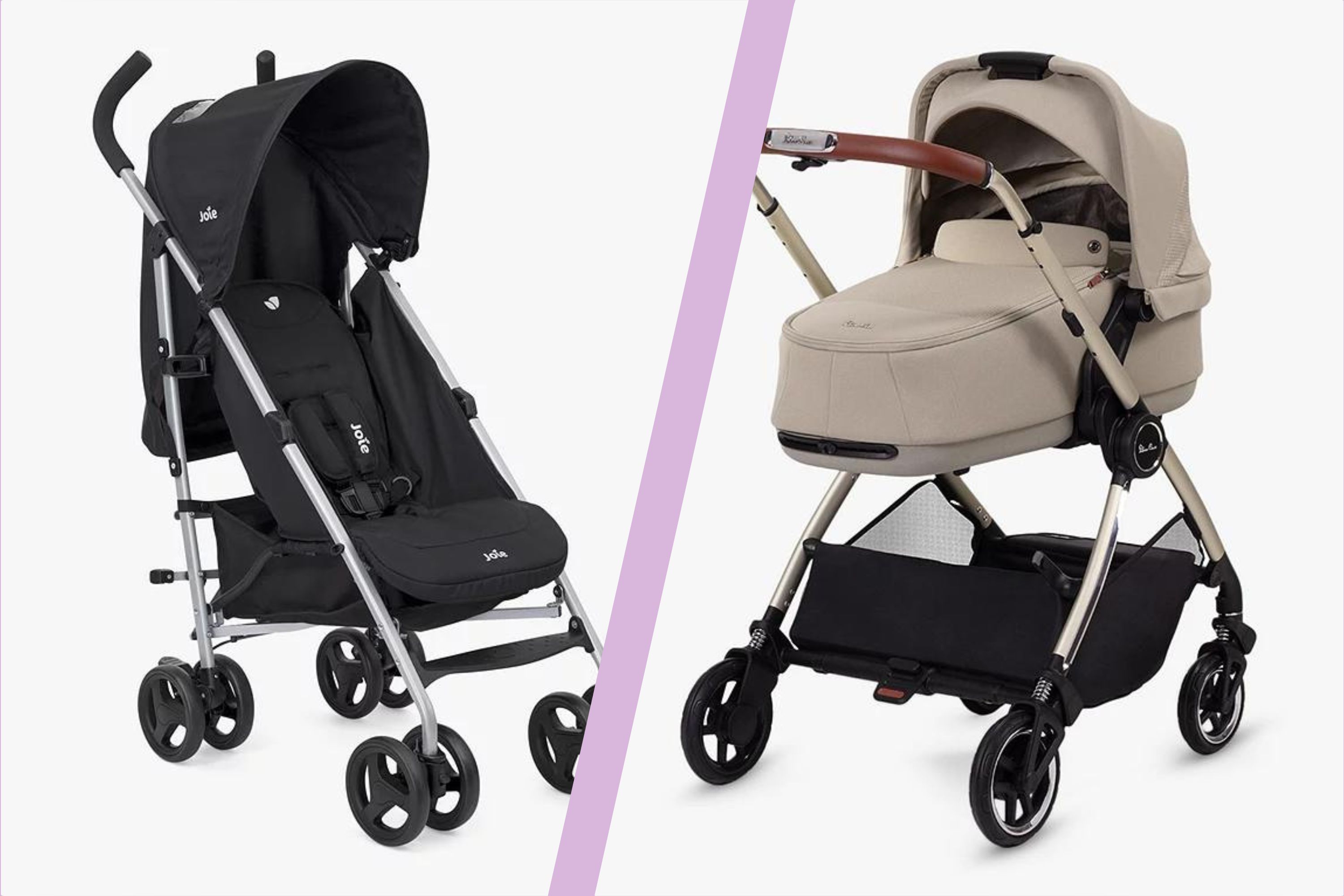Stroller Vs Pram - the 10 things we need to share before you make your choice
Stroller Vs Pram is a battle of the ages... here's what you need to know


Stroller Vs Pram, deciding which to buy can be a predicament for some parents. And we know that knowledge is power, so we've collated everything you need to know to make an informed choice.
With a new arrival comes a new decision; how to choose the best pram for your needs and your baby's needs, and it can be a little daunting. There's a huge array of options on offer covering a range of budgets, technology, and cool aesthetics. Choosing the best method of transportation for your baby can get even more complicated do you need a pram or a pushchair (also known as a stroller)?
Mum-of-two, Jas tells us; "I was clueless with my first and bought a pram that didn't do much so only used it for 9 months, before switching out for one that could change as my son grew. I wish I'd looked into it a bit more, to be honest."
If you need to know if a pram or stroller is more suited to a particular age, we have the lowdown on this to save you time researching. Once you're armed with the knowledge to take the plunge and buy, we've included an important pram and stroller safety checklist to go through - further reducing the stress of keeping your little one safe. You might even like to consider adding some pram or stroller toys to provide extra entertainment and stimulation while you're out and about. To make this decision easier, we've outlined the differences between a pram and a stroller, along with everything you need to know about each before making that all-important purchase.
Stroller Vs Pram
A pram is sturdier than a stroller and suitable for newborn and young babies to be carried flat. A stroller is more lightweight, and suited to older babies and toddlers.
A pram will be considerably durable, with a reclinable seat allowing very young babies to be transported laying flat. The reclining seat can often be altered to forward-facing, or facing the parent or person pushing. Prams sometimes feature a multi-system approach, where a car seat can be attached to the frame or swapped out to a carrycot or other reclined surface, and can be designed to easily navigate difficult terrain - these are often referred to as 3-in-1, 2-in-1, or travel systems, depending on the features included.
A stroller is suited to older babies and toddlers, and is generally lighter and easier to fold. Although prams generally fold flat too, a stroller will fold compactly and take up much less space in car boots and cupboards. Strollers are usually less sturdy than prams, and cheaper to purchase; they are unsuitable for those seeking adventure, as they won't easily glide over surfaces other than pavements. There is no parent-facing option with strollers either, with the older baby or toddler always facing forward.
Parenting advice, hot topics, best buys and family finance tips delivered straight to your inbox.
Stroller
Strollers are more basic than prams, usually coming in full-sized, lightweight, or double editions for multiples.
A full-sized stroller will be large and durable, and the most popular option. These will generally see your older baby or toddler through until they can walk longer distances and it's no longer required. However, weight restrictions remain and if your little one is heavier or resists walking until they're older, you'll need to make sure they haven't gone over the weight restriction. Strollers generally don't offer a lay-flat recline, but the back will drop back a little to allow some stroller snoozing.
Lightweight, or travel strollers, are the perfect option for taking on holiday and fold easily and quickly to take up a very small amount of space on the bus or train. Some even come with shoulder straps, folding up into the size of a small bag to be thrown easily over your shoulder. These do tend to be very basic, and strollers in general can be harder to manoeuvre than prams. Lightweight strollers usually have thinner wheels, making for a bumpier ride with less shock absorbance.
Things to consider when buying a stroller:
- Age of the baby or toddler - some strollers cater to different age groups, and you'll need to make sure you're selecting for the right age.
- Lifestyle - strollers make great town and city transportation options, but are less suited than going off-road in the countryside and uneven terrain.
- Storage - strollers usually have less storage than prams so if you still have plenty to carry, a 3 in 1 pram might be a better option.
- Budget - strollers can start at very reasonable prices, and this can be great if you just need one for a short time such as holidays and trips. Cheap ones might not last, however, if it's something you think you'll need in the long term.
- Ease of use - although strollers generally fold easily and take up less space, they can be more difficult to push and sometimes be less comfortable depending on the model.
- Easy to clean - some strollers have the option to remove the fabric and put it in the washing machine; this is the best and easiest way to clean and will be worth checking if this is possible.
- Hinges and sharp edges - strollers sometimes have hinges that little (and big - they really hurt!) fingers can become trapped in.
- Hidden extras - like prams, strollers don't always come with rain covers and UV protection. Consider what you'll need to keep your child comfortable in all weathers, and if they'll easily attach to the more basic stroller structure.
- Wheel quality - strollers may already offer less suspension than a pram and wheel quality is sometimes not as good, especially with cheaper models.
- Safety requirement - does the stroller meet the approved safety requirements?
Pram
As well as prams that move between being forward or parent-facing and travel system prams, all-terrain and jogging prams are available.
Single frame prams that come with a carrycot, car seat, and ability to turn into an upright position, are generally referred to as 3 in 1 systems. There is also a 2 in 1 option, allowing transformation of the carrycot into an upright seat. A travel system pram allows parents to simply remove the seat or carrycot altogether, replacing it with a car seat. This is perfect for transferring a snoozing infant from the car and straight to the pram without disturbing them.
All terrain pushchairs are fantastic for those who want to carry on experiencing an adventurous life, with a little one along for the ride. Robust, and often (although definitely not always) three-wheeled, all-terrain prams are designed to keep babies safe across multiple terrains. Look for dual suspension if this option is for you, which will provide extra support for the tiny adventurer in your life. Tyres should be puncture-proof, because nobody wants to be caught short with a flat tyre while ascending a hill or navigating a coastal path walk.
Jogging prams are large and stable, keeping babies comfortable over long distances and varying terrain; unlike other prams, babies under 6 months shouldn't be placed in jogging prams - they may even be unsafe for those under 12 months depending on user activity level. These prams are always three-wheeled, with specially designed wheels to bear the brunt of any impact. The large frame and wheels can be difficult to fold and manoeuvre, meaning they don't make a good everyday mode of transportation and can be difficult to fit inside shops and smaller spaces.
Things to consider when buying a pram:
- Longevity - how long will the pram last? If you opt for one with a carrycot that doesn't transform into an upright seat, it won't last as long as other options.
- Budget - there are many prams for different budgets, and it's worth researching reviews and currently available deals to get the best value for money.
- Features - which ones are best for your lifestyle? If you live in a city and are hopping on and off public transport, a travel system might be the best option. If you live in the countryside or spend plenty of time outdoors, an all-terrain or jogging pram might be better.
- The age of the baby - jogging prams aren't suitable for very small babies, and the infant age should be considered when buying any pram.
- Older siblings - do you need a pram that can handle a newborn and an older child? Double prams or attachments to transform a single pram to accommodate a toddler, can be purchased.
- Storage space - how much do you have in your home, and how big is your boot? You need to make sure the pram will fit in both before making your final choice.
- Accessories - not all prams will come equipped with UV sunshades, rain covers, and other items to protect the baby from the elements. Find out what is sold with the pram, and how costly extras might be.
- Easy to clean - babies can be messy, and should a vomit or nappy incident occur, being able to remove and wash the fabric will be essential.
- Smooth ride - although lightweight prams can be tempting, they can sometimes have less suspension and offer a bumpy ride. Consider the everyday terrain you'll be moving around on.
- Safety requirement - does the pram meet the approved safety requirements?
What age do you change from a pram to a stroller and why?
Babies can be moved from a pram to a stroller at around six-months old, or when they have the ability to sit up unaided.
Once a baby control their head movements and sit on their own, it is safe to switch them to a stroller if you wish. If a baby doesn't yet have that level of control over their head and neck, being in an upright position can present serious problems. There is a chance their head could fall forwards, placing pressure on their windpipe; if this occurs, breathing can become compromised and oxygen levels can drop.
Being in a seated position without being able to stop their head rolling forward can also place unwanted pressure on the chest and lungs. Hypoxia, or lack of oxygen, caused by pressure placed on the windpipe and chest area can result in suffocation. Laying flat until the parent is confident in the baby's ability to support their head, is important for breathing and well-being.
Pram and stroller safety checklist before buying
- Must comply with British Standard 7409:1996 or BSEN 1888.2003.
- The label should identify the manufacturer name, trademark, and identification, and display the British Standard number and date.
- Must comply with The Furniture and Furnishings (Fire) (Safety) Regulations 1988 and include a label bearing the caution "CARELESSNESS CAUSES FIRE". If one is not present, the pram or strollers do not meet the requirements of the Regulations.
- The brakes should be effective and easy to apply.
- Wheels should be securely attached and not show signs of damage.
- The frame should not be bent, damaged, or corroded.
- The fabric should not be damaged or torn.
- All prams and strollers will have a weight limit. Find out what it is and ensure your baby or toddler isn't too heavy.
- If buying a pram or stroller for two children, ensure the weight and safety features are appropriate to their individual ages.
- Check the backrest fully reclines when buying a pram for a newborn, as they will need to be transported flat until they can support their own head.
- Check the locking devices. Prams should have two, and they should both be functional designed to ensure fingers can't get caught in them.
- The safety harness should be functional, and five-pint is better than three-point.
- The safety harness should fit around the baby firmly, with no visible tears or damage to the straps.
- Check for appropriate places to store changing bags and shopping. Loading prams and strollers with bags in inappropriate places can result in them tipping over.
For more information on the best travel strollers we have a comprehensive guide, while making journeys with your baby has never been easier, with this handy information about the best baby car seats. For the money savers among you, one mum shares why she'd never spend more than £400 on a pram - parents and experts weigh in with their thoughts on the matter.
Video of the Week

Lucy is a mum-of-two, multi-award nominated writer and blogger with six years’ of experience writing about parenting, family life, and TV. Lucy has contributed content to PopSugar and moms.com. In the last three years, she has transformed her passion for streaming countless hours of television into specialising in entertainment writing. There is now nothing she loves more than watching the best shows on television and sharing why you - and your kids - should watch them.